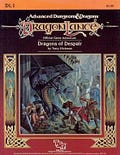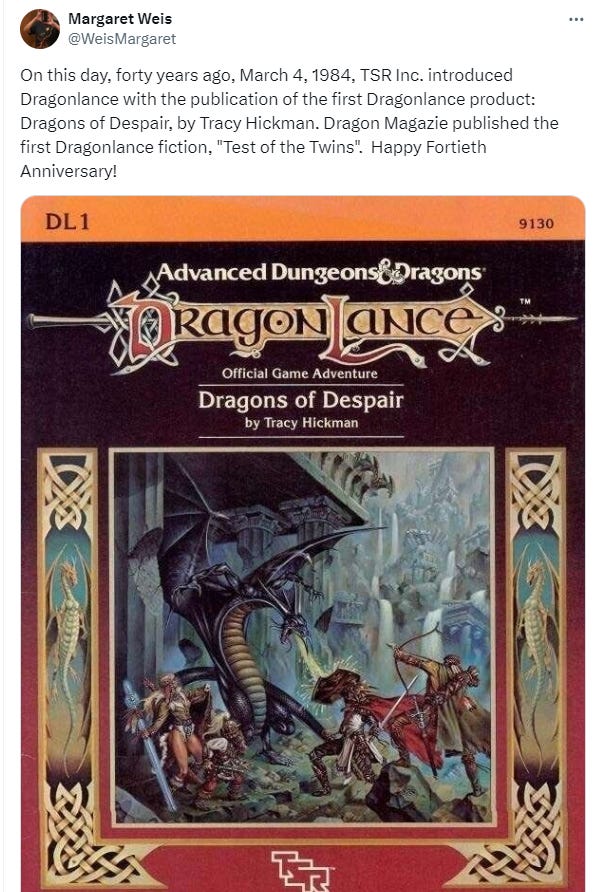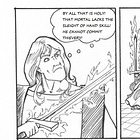It's the 40th Anniversary of "The Death of D&D"
Dragonlance and Sea Changes in Playing Styles
Why Are We Talking About the Death of D&D?
Okay, I admit it. That’s two click bait headlines in as many weeks. I couldn’t help myself with this one though. There has been a lot of chatter in my social media lately about an article over at the Realm Builder Guy blog entitled “This isn’t D&D; Anymore.” The article begins, as seems to be common of many articles recently, with a discussion of a recent Wizards of the Coast video talking about where D&D is today. It seems that WotC cannot, for the life of them, keep their feet out of their mouths when it comes to talking about the current state of the game versus prior iterations of D&D.
Last year, there was a HUGE kerfuffle when Wizards of the Coast suggested that they were going to kill the OGL and that their brand was under monetized. I found their claims of under monetization to be less than credible, but I did argue that they were a company in financial crisis. That crisis has continued into this past year when the company lost $1.5 billion dollars. That’s a lot of money for a corporation, even one as large as Hasbro, to lose. Add to this a number of unforced errors regarding the D&D brand. First their book production team allowed one of their products to be released with AI art. Then the same team failed to engage in proper oversite of the manufacture of the Deck of Many Things set that was supposed to release last November. Printing errors led to delays and the need for recalls. A lot has been made of the firing of multiple employees, but little of that speculation has discussed that the two major brand failures of the second half of 2024 were from the Art team.
Needless to say, this negative press environment and the upcoming release (also delayed) of what many think of as the 6th edition of D&D has created the perfect environment for a new “edition war” where long time fans lament the changes in the game. Realm Builder Guy sums up the latest declaration that D&D is dead by describing his view of how D&D was traditionally played.
When I think of Dungeons & Dragons, I think of endless adventures, delving into catacombs, exploring the unknown, and hopefully barely surviving to tell the tale at a local tavern with a treasure hoard hidden away. This really isn't what D&D is anymore...at least not entirely. A while back, Matthew Colville also addressed this topic in saying that the current 5th edition of D&D isn't designed with the same play experience in mind that you found in the game from 1974 - 1999. Yet despite the massive changes in play style, you still find certain remnants of the past within the equipment section of the PHB.
Note here the focus on “delving into catacombs, exploring the unknown, and hopefully surviving to tell the tale.” These are all iconic examples of D&D when it is played as a “emergent story” game rooted in some of the readings in Appendix N. The key to this kind of D&D game play is that it is highly focused on exploration by low powered adventurers who are lucky to make it part way through the dungeon before they flee and return home. This is the kind of play that we see advanced in Keep on the Borderlands, Isle of Dread, The Wizardry and Bard’s Tale video game franchises, and Robilar doing quick strike and flee forays into the Temple of Elemental Evil on his Carpet of Flying.
It is an engaging and fun way to play D&D. Survival and the acquisition of material goods are the primary motivators and any story comes from play and not from story seeds and branching plotlines. For many, this is how D&D played in their first gaming experiences. When there was a plot, as there is in the Giants through Demonweb Pits modules, it was driven more by hidden threats, behind hidden threats, that led to pressures on a near threat. For example, Lloth’s desire to have the Drow expand, put pressure on the Kuo Toa who needed to expand, which put pressure on the Giants, who attacked the local town. The adventurers discover the threats one layer at a time, eventually needing to go “further and further down a dungeon” to find the real threat. The focus was on exploration and not plot. The exploration reveals the plot.
But is that True? Did Early D&D Modules Focus on Exploration, not Plot?
They did not. Many early D&D modules, from our perspective, focused on plotlines and the attempt to complete a story. James Maliszewski likes to put the blame squarely at the feet of Tracy Hickman. In his 2008 essay, How Dragonlance Ruined Everything, Maliszewski argues that the problem with Dragonlance, and subsequent modules, was that:
From that point on, “story" came to dominate the way D&D and other RPGs were presented. No longer were adventures "modules," implying they could be swapped in and out of campaigns with minimal impact. Now, they had to tell a coherent narrative that was dramatically satisfying. Instead of "just a bunch of stuff that happens," adventures had to make sense.
Though some of his critiques in his post are incorrect, and demonstrate that he’s never actually run the modules or maybe even read them1, where he is correct is that Dragonlance marked a point in D&D’s development as a game product where “story” rather than mere exploration began to dominate the published materials. As James further explored the topic, he realized that this trend pre-dated Dragonlance and was a key feature of most of Tracy Hickman’s modules like Ravenloft. He argues that Dragonlance was different from, if an evolution of, the Ravenloft formula because of the integration of IP and adventure. I think he’s onto something there regarding what would become a huge trend in RPGs in the 90s, the use of metaplots, but I think he’s also wrong.
You see, as much as my own early gaming was of the exploration type. I eventually became bored with the “go down, fight, come back, rest” form of play. It’s an exciting form of play for the beginner, and it appears that according to FGU’s short lived Wargaming magazine it was the same way that Gygax played when David Arneson introduced him to the concept of dungeon crawl adventuring (I will have a quote from that magazine later tonight when I’m at home and have access to my copy so you might want to come back and reread just for that). For my group, this kind of adventuring eventually spiraled into “Christian opens up the Monster Manual and rolls on the encounter tables to see what the players are fighting this time” lazy DMing. It doesn’t have to lead that way, but when you are fourteen it can. The “just exploring” kind of gaming can be great, but it can also be limiting and become formulaic.
Thankfully, D&D gamers didn’t have to wait until Ravenloft or Dragonlance were published to find adventures that were story driven. As early as 1981 with the publication of U1 The Sinister Secret of Saltmarsh, L1 The Secret of Bone Hill, TSR was publishing adventure modules that were story driven murder mysteries. In 1982, these were followed up with N1 Against the Cult of the Reptile God which also featured story driven elements. Maliszewski’s own beloved Slave Lords series has a couple of extreme rail road moments, like the capture of the PCs, that make the adventures more rewarding. In the case of the Slave Lords adventure, it’s the result of them being tournament modules. In the case of Saltmarsh though, it marks a change in over all playing style.
My own gaming experience changed drastically when I first read B6 The Veiled Society. The adventure as written is very straight forward, and a bit of a linear rail road to solution, but it is an adventure that I use to start most of my ongoing campaigns. I manage this by using a Hickmanian trick. In Ravenloft, Tracy Hickman has the DM randomly determine the location of several items and the motivation for the module’s villain. I used this as inspiration for how I run The Veiled Society. The key to that adventure is that one of the three “old families” of Karameikos seeks to undermine Duke Stephen by using their cadre driven organized criminal organization to inflict terror on the city of Specularum. There’s a murder and the player characters are asked to step in as neutral parties.
As a huge fan of Dashiell Hammett, The Glass Key and Red Harvest in particular, I like to encourage the players to explore the three factions to see who is responsible and to disrupt the action. There are also a couple of other factions added to the mix (the Thieves’ Guild run by Flameflicker, the City Watch, the Church of Traladara, and the Church of Karameikos to name a few) who all have their own motivations. These motivations change from campaign to campaign, but the inciting incident remains the same. Sometimes the Radu are the villains, sometimes the Torenescu. It’s never the same, but story always comes first. I will have plotted motivations for everyone before I run a single session.
The thing is, that’s not the same as scripting. I have not determined how the PCs will act. Sometimes, they will side with the “baddies” intentionally and sometimes unintentionally. The end result is still emergent, even though the “script” of the module is very linear. I have yet for game play to be so. In fact, my games using this scripted module is less linear than when I was running “exploration” based games.
What Does All this Mean?
As you might have guessed, I don’t think that modern D&D is broken. I’ve discussed at length my concerns with a mechanics based mindset in my post on liking D&D before it became GURPS (yep, that was the other click bait headline).
I think that the original rules for D&D make a great game. I think that exploration and emergent storytelling make for fantastic D&D campaigns. I also think that story driven games are fun and I KNOW that those were a part of early D&D too. Maybe too many players today don’t get to experience the fun of the exploration based style of play. There’s a reason I love, and I mean I LOVE, dungeon crawl board games. There’s something liberating about not having to worry if your character lives through the current session. It’s fun to just roll up a new character named Doshua to replace his dead brother Joshua. It ensures that the game remains a game, and that is really important.
Modern gamers aren’t playing D&D the wrong way, but many of them are only playing it one way and they are missing out on all of the other ways to play. Story based adventures have been around since day one, though they took a back seat to explorative and emergent play. Today story based play is the expectation and players are missing out on a lot of fun if they only play that way.
So Happy 40th Birthday Dragonlance and thank you for ruining D&D 40 years ago. It’s time for me to keep working on my Heroes of Karameikos game so that I can ruin it in a different direction.
For example, Sturm Brightblade may die in the books, but he does not have to die in your running of the modules and his character is featured as an option to use in DL14 which happens long after the Sturm of the books dies. In fact, players can use their own characters if they want.









Facts...
I designed my own system because I couldnt take it ...
I can send you the document if you like
WHAT IS WEZ’S Twisted homebrew.
It's a mashup of all the greatest stuff of the last 40+ years of fantasy gaming blended into a simple system perfect for online play, run by an attentive experienced DM.
It's kind of like a Distilled essence.
On the fly the DM can use any item, monster or idea from any system, only limited by imagination.
Many DMs have the skill to convert on the fly. Any adventure from any system can be used with any characters from any system. Remember the game only advances one round at a time.
WHAT IT'S NOT.: It's not Complete game. It does not teach anyone how to play. It's for an experienced DM and experienced but possibly jaded players that want something old but new.
It's DUNGEONS AND DRAGONS and it's all the good stuff..
From Assassin Class and the Potion miscibility table, to Sorcerer Bloodlines. I've put in everything I liked over the last 40 years and added decades of house ruled homebrew. And it works and it's fun.
It's Slightly harder… and it's slightly more magic scarce, and me and my players think it's slightly more fun.
I humbly proffer Wez’s twisted homebrew as a free gift to the world's gamers.
As someone who had played D&D up to 5E, I still think 2E is the best hands down. As to Dragonlance, that setting was in my mind the best setting ever created; Raistlin, Caramon, etc.
Also the DOS based games were incredible in their simplicity and genius in their story telling. Please turn to page 32 and read journal entry 13 to hear more about your journey.